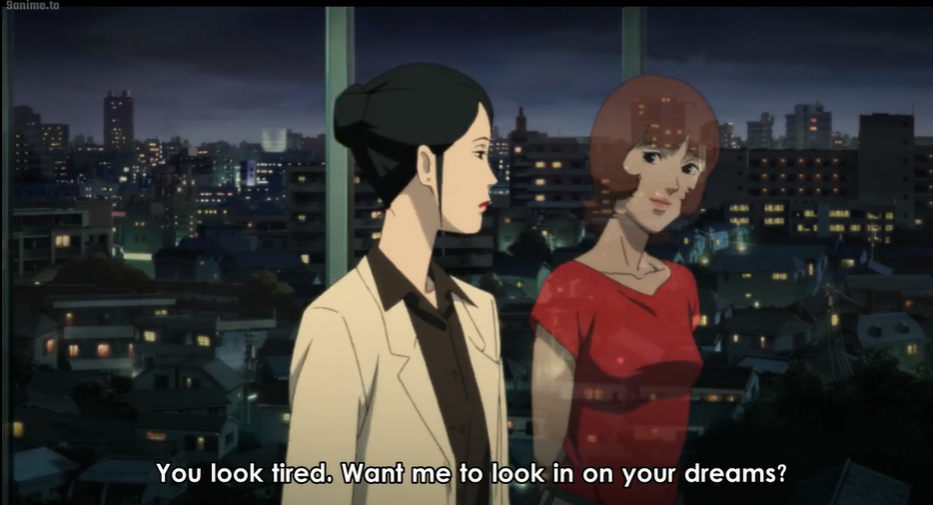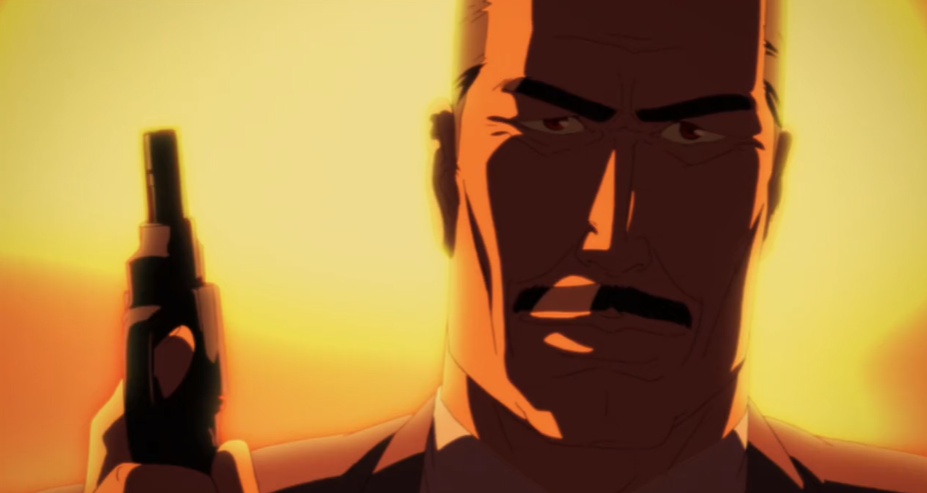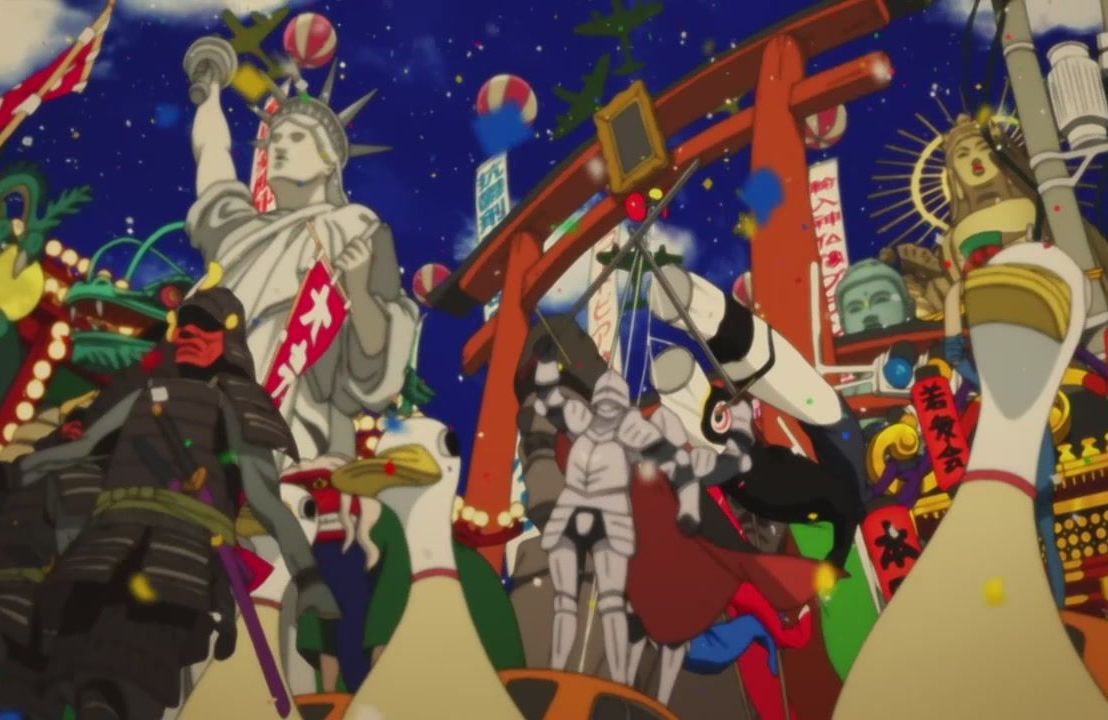I shall now be making my first movie review of the year! Satoshi Kon’s Paprika, like my investigation into Little Nemo: Adventures In Slumberland and Netflix’s Slumberland, focuses on the world of dreams. Instead of focusing solely on characters who navigate through a dream world and has their adventures there recorded for our amusement, here the film explores the blurring divide between what’s real, and what’s a mere fantasy; bringing along with it a production that’s leans darker, more serious, and is less whimsical than the former. I should also add that this film’s a little bit more geared towards the mature end, given how there are scenes that could lean inappropriate for certain individual groups. You’ll understand which ones as I explain further down.
Paprika

Paprika, directed by famed Japanese anime director Satoshi Kon, came out in 2006, four years before his death from pancreatic cancer; as a result, this wound up being his fourth and final feature film (his fifth production, Dreaming Machine, was never finished at the time of his passing; nor will it ever be released in the future). Inspired by Yasutaka Tsutsui’s eponymous 1993 novel, conceptually this film had been in the works for eight years, and faced production difficulties when Rex Entertainment, who financed Perfect Blue, went bankrupt – thus leading Kon to have famed studio Madhouse over the span of two years, releasing a month after the folks there brought Death Note out into the open.
With a heavy emphasis on the topic of illusions and reality, the film has received widespread fame and hailed as a perfect send-off to Satoshi Kon’s short, but illustrious career. Aside from winning three awards at several minor international film festivals, it is also known for having allegedly inspired the creation of Christopher Nolan’s 2010 mystery-thriller Inception on account of the shared themes, which, having watched both films I can definitely concur there’s something eerily familiar amongst them; though to its credit the latter is a lot more cleaner and less acid-trip inducing than Paprika.
Plot
Scientist Dr. Atsuko Chiba and computer engineer Kosaku Tokita are part of a scientific team behind the creation of the DC Mini, a device brainchilded by the latter, that enables users to enter other peoples’ dreams and tinker around them. Envisioned as a cutting-edge tool for psychiatry, allowing practitioners such as Dr. Chiba (under the alter-ego “Paprika”) to treat their patients better and reach the source of their problems, some of its critics include the paraplegic chairman, Inui, who looks down at it with scorn for its invasive methodology. His point seems to be proven in the form of Himuro, Tokita’s friend/rival who prior became a test subject of the experiment, and remains trapped in a dream parade with him assuming a kingly role and unable to escape from it. Eventually, due to the device’s low security and its practically universal accessibility, members of the scientific lab break down into hysterics, their subconscious having been mysteriously infiltrated leaving them screeching nonsensical poems about their fantasies.
On the side, Dr. Chiba works with a police detective, Toshimi Konakawa, who is seen in the film’s opening having recurring theatrical dreams about his best friend which seem to go nowhere and always end with him chasing its silhouette to an empty hotel hallway, where he comes face to face with a vignette of him shooting himself, leaving his target to escape. Faced with the threat of their project being scrapped by their ever-so stoic chairman Inui, Chiba, assuming her identity as Paprika, jumps into the dream-world of the DC Mini to find the source of the issue, where she stumbles upon its root cause: her colleague, Dr. Morio Osanai, who is working to prevent the DC Mini’s success and safeguard the sanctity of dreams under the tutelage of his supervisor, none other than Inui himself. As she is captured, the filter between the dream world and reality breaks down, as Himuro’s dream starts to invade Konakawa’s and consumes Tokita, in the shape of a robot, in the process. Paprika is captured, and after a very borderline-rapey scene (hence my warning), she is rescued by Konakawa who promptly chases Osanai down through his dream path; at the final segment, which he always struggled to move at, he finally takes action and shoots Osanai, killing him in the process.
The act proves more than symbolic: it reconciles Konakawa with his sheltered feelings regarding his best friend, who he used to make movies with prior to his unfortunate early death; and yet harbored slight jealousy towards him because he seemed to always one-up him at various places, like sports. Overcoming that, he finds peace with those emotions, and can restore his love for movies. Just as he does that, the barrier between reality and dreams breaks down, causing the dream parade to drive everyone crazy: people turning into statues of Buddha, lucky cats and the Blessed Virgin Mary (…yeah, don’t ask, I have nothing to say other than “who thought this was a good idea to portray”), having cellphone heads, talking dolls and businessmen hysterically dancing and jumping off buildings. Chiba and her superior, Dr. Shima, are pursued by Himuro’s doll, which screams at them, but thanks to the breakdown Paprika arrives to give the duo some added leverage and a way around the chaos. Amidst this, Paprika unwittingly helps Chiba to reveal her hidden crush on Tokita, thus reconciling their identities and enabling him to snap back to reality.
Inui transforms into a dark, tall, god-like structure declaring his power over reality and dreams, but in a stunning deus ex machina move, Paprika defeats him by absorbing air, which somehow sucks him up too and ends the torrent. The film ends with Konakawa buying a ticket to a movie, choosing to accept his path in life as a detective and honoring his friend’s memory, while Tokita and Chiba announce their expectation of a child together.
What I Liked
- I liked that the film provided two perspectives on the “DC Mini” and its usage. On one hand, in Konakawa’s case it proved to be a mental life-saver as it allowed him to contemplate why he felt bitter towards his friend, and do something about that gripe, proving Drs. Chiba and Tokita’s point about it being a breakthrough in psychological work; on the other hand, the chairman’s conviction that it can be used to terrorize people due to its open-source access was also depicted, and the chaos which ensued.
- Konakawa’s journey, speaking of which, was the best part of this flick, as was his interaction with Paprika. In my opinion, it’s the film’s greatest strength, and I’m glad that they put it in as a side story. The lessons it convoked, the details surrounding his troubles and past, the integration of his character, emotions and all was satisfying to see play out; and the integration of movies, his rocky bond to them and its prominent place as a part of his subconscious resonated with me, as someone who literally writes reviews about anime as a hobby.
- The layout of the various dream worlds was a bit convoluted in its development, but still doesn’t stop it from being a pleasing show of the movie’s animated capabilities combined with the fitting atmosphere of either dread, calm, or wonder that each of them called out. My favourites included Himuro’s nightmarish amusement park, the Radio Club bar of Paprika’s musings and Konakawa’s hall of theatres.
- Ultimately, the film’s main message about dreams and reality was not lost on me, and I understood it as a call for us to neither be too engrossed in reality to the point of abandoning our goals, nor be stuck in delusion; in fact, it seeks us to come to terms with our dreams and make an effort to realize them while we can. Basically, the Shia LaBoeuf meme and the Nike motto piled together as a movie: “DO IT! JUST DO IT! DON’T LET YOUR DREAMS BE DREAMS, etc”.
What I Didn’t Like
- Funnily enough, while many characters are given a name to their faces, the chairman, the bartenders from Konakawa’s dream and his deceased friend get the dubious honour of being NEVER ONCE IDENTIFIED BY NAME throughout the film, which was rather curious. You could say that this will get them inspired to pick up the actual novel and read it to find out who they are and learn more about them, but still, why not just identify them right here and now instead of having us shuffle through that trouble?
- That deus ex machina ending. Between Dr. Chiba suddenly being able to morph into a baby by jumping out of Dr. Tokita’s robotic armour, and gain the ability to suck up the dreams’ essence, while the chairman just stands around, not even with an ounce of resistance before having her gigantic naked form (!!) exposed in some triumphant glare, it was too anti-climactic and not to mention, nonsensical to boot. Then again, I shouldn’t expect much considering how wacky the whole last 20 minutes was. It did get me to exclaim “What kind of #*(&@% up movie is this??” at the sight, as if that was its intended effect.
- The software developer in me just wants to slap whoever programmed, tested and approved Dr. Tokita’s “DC Mini” device. In an age where cyber-attacks are something to pay great heed to, and the valuable asset they are trying to play with, how could the be so naïve to program a device WITHOUT ANY SECURITY REINFORCEMENTS, OR A COHERENT QA PROCESS? AND WHY IS THAT EVEN A THING FOR THE PLOT? Moreover, I had to balk at how over-glorified they made the device seem, as the thing of the future without actually going into the specifics of how it operates; like how the hackers could gain access to it and manipulate its victims, for example, or how dreams are recorded into the software. That warranted some explanation instead of just being a “you got to believe it happened” situation!
Characters


Before moving to this, I’m going to say the one thing that many people have criticized in this category: yes, the Tokita/Chiba romance shtick made absolutely no sense, and I wasn’t on board with how it formed. You can tell me all about how Chiba gave him more attention than anyone else in the cast or pull out some tsundere justification out of the air and it still wouldn’t make it any better. However, that’s not to say that the characters were all that bad; the characters knew their places and acted accordingly without breaking their persona. I watched this film twice, and I’ve come to appreciate how they’re setup in the second run. For one thing, each character’s personality in the real world compared with that in their dreams was brilliantly contrasted; the normally serious and stern Dr. Chiba and the bubbly, extroverted Paprika being the most notable one, capping the film’s theme and sorting out its tension. The character relationships had Konakawa’s patient-peer communication with Paprika topping the list, especially regarding their depth and how well Paprika carried out the psychoanalytic functions as opposed to Konakawa’s resilience to resist, then come to terms with the turmoil surrounding his best friend; while Inui’s borderline-gay relationship with Osanai and that shtick with Himuro and Tokita were not really that well-developed, or presented anything notable.
Music
For the first time in a while I’m reviewing a movie with no vocal tracks – which is a relief, and not that it needed any; I think it would have been hard to write a song for this movie’s themes that isn’t a cheesy 1980s ballad. The music in the dream sequences was ethereal and reflected waves of mystery throughout, like when Paprika and Tokita searched through the remnants of Himuro’s dream, which resembled an abandoned amusement park or the hallway parts of Konakawa’s sequence. I have to mention as well, the music also captured the chills of the empty environments and how unexpected they can be. If I didn’t know any better, I’d think these all came from either a psychological horror or a miscellaneous mystery flick; you know, when the character stumbles upon an important clue or a significant hideout. Then you have the mystical, yet earwormy theme song of the dream parade below, in all its bombastic, chaotic and cheerful glory which lends to the surreal nature that lies within Paprika, which best summarizes the film’s at-times psychedelic nature.
Favourites
Favourite character: Detective Konakawa is not only the strongest character of this movie both physically and mentally, but he’s also the deepest character of them all; a man with a broken past who overcomes that with Paprika’s help and through his own unbroken volition carving a new life for himself. When written well, these characters are a gold mine to think upon.
Favourite scene: When Konakawa chases down Osanai and, in the hallway scene, instead of standing frozen in terror by the sight of his alternate self being shot dead, he takes action, and “finishes” the movie-like sequence by gunning down Osanai, followed by blowing the smoke off his gun, looking at the camera and saying: “That’s all, folks” – to the cheering audience of his best friend’s lookalikes. That was very cool.

Favourite quote: I felt that stretch of awesome in the last exchange between his best friend’s hologram prior to him gunning down Osanai:
Dr. Shima: So, did you find out what was causing your dream?
Konakawa: Hmmm, what was it, I wonder?
Konakawa’s friend: Why have you been sulking all this time? Didn’t you become a cop out of a desire to live out our dream movie in the real world? Remember, truth comes from fiction – now go out and live it fully, partner!
Konakawa: Yes, to everything about that!
Konakawa finally regains the will to live, and no longer is trapped by his unfulfilled longings
Conclusion
Paprika… is quite the specimen, I’ve got to say. At times it felt monotone and the story takes a while to materialize, if not has some rather dark and unsettling moments to boot. But at its best, it’s a flick that’s filled with some thought-provoking meaning and has an astounding ability to convey that through fluid visuals and exploring the characters’ ambitions during its screen-time, particularly through their conflicting beliefs. Yet, the convoluted writing, treatment of its plot elements and its shock-value scenes were not the cleanest, and because of its lack of direction I had to watch this film several times before grasping what it was about. Because of that, I will only say that it’s enjoyable insofar as its theme goes, but when it comes to delivery, much could have been handled better. That being said, I wonder how it stacks up to Satoshi Kon’s other works, given that he really loves exploring the dreams/reality boundary.
FINAL SCORE: 6.8/10









One thought on “Anime Review #94: Paprika”